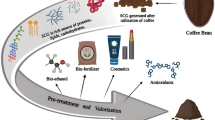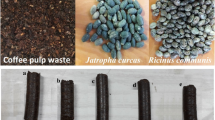Abstract
Spent coffee grounds (SCG) and coffee silverskin (CS) represent a great pollution hazard if discharged into the environment. Taking this fact into account, the purpose of this study was to evaluate the chemical composition, functional properties, and structural characteristics of these agro-industrial residues in order to identify the characteristics that allow their reutilization in industrial processes. According to the results, SCG and CS are both of lignocellulosic nature. Sugars polymerized to their cellulose and hemicellulose fractions correspond to 51.5 and 40.45 % w/w, respectively; however, the hemicellulose sugars and their composition significantly differ from one residue to another. SCG and CS particles differ in terms of morphology and crystallinity, but both materials have very low porosity and similar melting point. In terms of functional properties, SCG and CS present good water and oil holding capacities, emulsion activity and stability, and antioxidant potential, being therefore great candidates for use on food and pharmaceutical fields.




Similar content being viewed by others
Abbreviations
- CS:
-
Coffee silverskin
- DPPH:
-
2,2-diphenyl-1-picrylhydrazyl
- DSC:
-
Differential scanning calorimetry
- EA:
-
Emulsifying activity
- ES:
-
Emulsion stability
- FRAP:
-
Ferric reducing antioxidant power
- FTIR:
-
Fourier transform infrared spectroscopy
- ICP-AES:
-
Inductively coupled plasma atomic emission spectrometry
- IDF:
-
Insoluble dietary fiber
- ICDD:
-
International Centre for Diffraction Data
- OHC:
-
Oil holding capacity
- SEM:
-
Scanning electron microscopy
- SDF:
-
Soluble dietary fiber
- SBET :
-
Specific surface area
- SCG:
-
Spent coffee grounds
- TGA:
-
Thermogravimetric analyses
- TDF:
-
Total dietary fiber
- TE:
-
Trolox equivalents
- WHC:
-
Water holding capacity
- XRD:
-
X-ray diffraction
References
Ao, C., Higa, T., Khanh, T. D., Upadhyay, A., & Tawata, S. (2011). Antioxidant phenolic compounds from Smilax sebeana Miq. LWT - Food Science and Technology, 44(7), 1681–1686.
Arya, M., & Rao, L. J. M. (2007). An impression of coffee carbohydrates. Critical Reviews in Food Science and Nutrition, 47(1), 51–67.
Barrett, E. P., Joyner, L. G., & Halenda, P. P. (1951). The determination of pore volume and area distributions in porous substances. I. Computations from nitrogen isotherms. Journal of the American Chemical Society, 73(1), 373–380.
Betancur-Ancona, D., Peraza-Mercado, G., Moguel-Ordoñez, Y., & Fuertes-Blanco, S. (2004). Physicochemical characterization of lima bean (Phaseolus lunatus) and Jack bean (Canavalia ensiformis) fibrous residues. Food Chemistry, 84(2), 287–295.
Borrelli, R. C., Esposito, F., Napolitano, A., Ritieni, A., & Fogliano, V. (2004). Characterization of a new potential functional ingredient: Coffee silverskin. Journal of Agricultural and Food Chemistry, 52(5), 1338–1343.
Brunauer, S., Emmett, P. H., & Teller, E. (1938). Adsorption of gases in multimolecular layers. Journal of the American Chemical Society, 60(2), 309–319.
Chau, C.-F., Cheung, P. C. K., & Wong, Y.-S. (1997). Functional properties of protein concentrates from three Chinese indigenous legume seeds. Journal of Agricultural and Food Chemistry, 45(7), 2500–2503.
Cummings, J. H., Branch, W., Jenkins, D. J. A., Southgate, D. A. T., Houston, H., & James, W. P. T. (1978). Colonic response to dietary fiber from carrot, cabbage, apple, bran, and guar gum. The Lancet, 1(8054), 5–9.
Femenia, A., Lefebvre, A.-C., Thebaudin, J.-Y., Robertson, J. A., & Bourgeois, C.-M. (1997). Physical and sensory properties of model foods supplemented with cauliflower fiber. Journal of Food Science, 62(4), 635–639.
Figueiró, S. D., Góes, J. C., Moreira, R. A., & Sombra, A. S. B. (2004). On the physic-chemical and dieletric properties of glutaraldehyde crosslinked galactomannan—Collagen films. Carbohydrate Polymers, 56(3), 313–320.
Horwitz, W., & Latimer, G. W., Jr. (2005). Official methods of analysis of AOAC International (18th ed.). Gaithersburg, Maryland, USA: AOAC International.
Kemsley, E. K., Ruault, S., & Wilson, R. H. (1995). Discrimination between Coffea arabica and Coffea canephora variant robusta beans using infrared spectroscopy. Food Chemistry, 54(3), 321–326.
Kuan, Y.-H., & Liong, M.-T. (2008). Chemical and physicochemical characterization of agrowaste fibrous materials and residues. Journal of Agricultural and Food Chemistry, 56(19), 9252–9257.
Kuan, C.-Y., Yuen, K.-H., Bhat, R., & Liong, M.-T. (2011). Physicochemical characterization of alkali treated fractions from corncob and wheat straw and the production of nanofibres. Food Research International, 44(9), 2822–2829.
Machado, E. M. S., Rodriguez-Jasso, R. M., Teixeira, J. A., & Mussatto, S. I. (2012). Growth of fungal strains on coffee industry residues with removal of polyphenolic compounds. Biochemical Engineering Journal, 60, 87–90.
Martins, S., Aguilar, C. N., Teixeira, J. A., & Mussatto, S. I. (2012). Bioactive compounds (phytoestrogens) recovery from Larrea tridentata leaves by solvents extraction. Separation and Purification Technology, 88, 163–167.
Maydata, A. G. (2002). Café, antioxidantes y protección a la salud. Medisan, 6(4), 72–81.
Meneses, N. G. T., Martins, S., Teixeira, J. A., & Mussatto, S. I. (2013). Influence of extraction solvents on the recovery of antioxidant phenolic compounds from brewer’s spent grains. Separation and Purification Technology, 108, 152–158.
Mesa, L., González, E., Cara, C., González, M., Castro, E., & Mussatto, S. I. (2011). The effect of organosolv pretreatment variables on enzymatic hydrolysis of sugarcane bagasse. Chemical Engineering Journal, 168(3), 1157–1162.
Murthy, P. S., & Naidu, M. M. (2012). Recovery of phenolic antioxidants and functional compounds from coffee industry by-products. Food and Bioprocess Technology, 5(3), 897–903.
Mussatto, S. I., Ballesteros, L. F., Martins, S., Maltos, D. A. F., Aguilar, C. N., & Teixeira, J. A. (2013). Maximization of fructooligosaccharides and β-fructofuranosidase production by Aspergillus japonicus under solid-state fermentation conditions. Food and Bioprocess Technology, 6(8), 2128–2134.
Mussatto, S. I., Ballesteros, L. F., Martins, S., & Teixeira, J. A. (2011a). Extraction of antioxidant phenolic compounds from spent coffee grounds. Separation and Purification Technology, 83, 173–179.
Mussatto, S. I., Carneiro, L. M., Silva, J. P. A., Roberto, I. C., & Teixeira, J. A. (2011b). A study on chemical constituents and sugars extraction from spent coffee grounds. Carbohydrate Polymers, 83(2), 368–374.
Mussatto, S. I., Fernandes, M., Rocha, G. J. M., Órfão, J. J. M., Teixeira, J. A., & Roberto, I. C. (2010). Production, characterization and application of activated carbon from brewer’s spent grain lignin. Bioresource Technology, 101(7), 2450–2457.
Mussatto, S. I., Machado, E. M. S., Carneiro, L. M., & Teixeira, J. A. (2012). Sugars metabolism and ethanol production by different yeast strains from coffee industry wastes hydrolysates. Applied Energy, 92, 763–768.
Mussatto, S. I., Machado, E. M. S., Martins, S., & Teixeira, J. A. (2011c). Production, composition, and application of coffee and its industrial residues. Food and Bioprocess Technology, 4(5), 661–672.
Mussatto, S. I., & Roberto, I. C. (2006). Chemical characterization and liberation of pentose sugars from brewer's spent grain. Journal of Chemical Technology & Biotechnology, 81(3), 268–274.
Mussatto, S. I., & Teixeira, J. A. (2010). Increase in the fructooligosaccharides yield and productivity by solid-state fermentation with Aspergillus japonicus using agro-industrial residues as support and nutrient source. Biochemical Engineering Journal, 53(1), 154–157.
Paradkar, M. M., & Irudayaraj, J. (2002). Rapid determination of caffeine content in soft drinks using FTIR–ATR spectroscopy. Food Chemistry, 78(2), 261–266.
Pourfarzad, A., Mahdavian-Mehr, H., & Sedaghat, N. (2013). Coffee silverskin as a source of dietary fiber in bread-making: Optimization of chemical treatment using response surface methodology. LWT - Food Science and Technology, 50(2), 599–606.
Ragauskas, A. J., & Huang, F. (2013). Chemical pretreatment techniques for biofuels and biorefineries from softwood. In Z. Fang (Ed.), Pretreatment techniques for biofuels and biorefineries. Berlin: Springer.
Raghavendra, S. N., Rastogi, N. K., Raghavarao, K. S. M. S., & Tharanathan, R. N. (2004). Dietary fiber from coconut residue: Effects of different treatments and particle size on the hydration properties. European Food Research and Technology, 218(6), 563–567.
Ravindranath, R., Yousuf Ali Khan, R., Oby Reddy, T., Thirumala Rao, S. D., & Reddy, B. R. (1972). Composition and characteristics of Indian coffee bean, spent ground and oil. Journal of the Science of Food and Agriculture, 23(3), 307–310.
Reis, N., Franca, A. S., & Oliveira, L. S. (2013). Discrimination between roasted coffee, roasted corn and coffee husks by Diffuse Reflectance Infrared Fourier Transform Spectroscopy. LWT - Food Science and Technology, 50(2), 715–722.
Ribeiro, J. S., Salva, T. J., & Ferreira, M. M. C. (2010). Chemometric studies for quality control of processed Brazilian coffees using DRIFTS. Journal of Food Quality, 33(2), 212–227.
Rivera, W., Velasco, X., Gálvez, C., Rincón, C., Rosales, A., & Arango, P. (2011). Effect of the roasting process on glass transition and phase transition of Colombian Arabic coffee beans. Procedia Food Science, 1, 385–390.
Roberto, I. C., Mussatto, S. I., & Rodrigues, R. C. L. B. (2003). Dilute-acid hydrolysis for optimization of xylose recovery from rice straw in a semi-pilot reactor. Industrial Crops and Products, 17(3), 171–176.
Robertson, J. A., Monredon, F. D., Dysseler, P., Guillon, F., Amado, R., & Thibault, J. F. (2000). LWT - Food Science and Technology, 33(2), 72–79.
Sampaio, A., Dragone, G., Vilanova, M., Oliveira, J. M., Teixeira, J. A., & Mussatto, S. I. (2013). Production, chemical characterization, and sensory profile of a novel spirit elaborated from spent coffee ground. LWT – Food Science and Technology, 54(2), 557–563.
Sánchez-Zapata, E., Fuentes-Zaragoza, E., Fernández-López, J., Sendra, E., Sayas, E., Navarro, C., & Pérez-Álvarez, J. A. (2009). Preparation of dietary fiber powder from tiger nut (Cyperus esculentus) milk (“Horchata”) byproducts and its physicochemical properties. Journal of Agricultural and Food Chemistry, 57(17), 7719–7725.
Silva, M. A., Nebra, S. A., Machado Silva, M. J., & Sanchez, C. G. (1998). The use of biomass residues in the Brazilian soluble coffee industry. Biomass and Bioenergy, 14(5–6), 457–467.
Sluiter, A., Hames, B., Ruiz, R., Scarlata, C., Sluiter, J., Templeton, D., & Crocker, D. (2010). Determination of structural carbohydrates and lignin in biomass. Technical Report NREL/TP-510-42618.
Sluiter, A., Ruiz, R., Scarlata, C., Sluiter, J., & Templeton, D. (2008). Determination of extractives in biomass. Technical Report NREL/TP-510-42619.
Sperling, L. H. (2006). Introduction to physical polymer science (4th ed.). New Jersey: Wiley.
Stewart, D. (2008). Lignin as a base material for materials applications: Chemistry, application and economics. Industrial Crops and Products, 27(2), 202–207.
Sun, R. C., Sun, X. F., Fowler, P., & Tomkinson, J. (2002). Structural and physico-chemical characterization of lignins solubilized during alkaline peroxide treatment of barley straw. European Polymer Journal, 38(7), 1399–1407.
Tiwari, U., & Cummins, E. (2011). Pulse foods: Processing, quality and nutraceutical applications (pp. 121–156). San Diego: Academic.
Acknowledgements
The authors acknowledge the financial support of the Science and Technology Foundation of Portugal (FCT) through the grant SFRH/BD/80948/2011 and the Strategic Project PEst-OE/EQB/LA0023/2013. The authors also thank the Project “BioInd - Biotechnology and Bioengineering for improved Industrial and Agro-Food processes", REF. NORTE-07-0124-FEDER-000028 co-funded by the Programa Operacional Regional do Norte (ON.2-O Novo Norte), QREN, FEDER. Thanks are also given to Prof. José J.M. Órfão, from the Department of Chemical Engineering, Universidade do Porto (Portugal), for his assistance with the porosity analyses.
Author information
Authors and Affiliations
Corresponding author
Rights and permissions
About this article
Cite this article
Ballesteros, L.F., Teixeira, J.A. & Mussatto, S.I. Chemical, Functional, and Structural Properties of Spent Coffee Grounds and Coffee Silverskin. Food Bioprocess Technol 7, 3493–3503 (2014). https://doi.org/10.1007/s11947-014-1349-z
Received:
Accepted:
Published:
Issue Date:
DOI: https://doi.org/10.1007/s11947-014-1349-z




